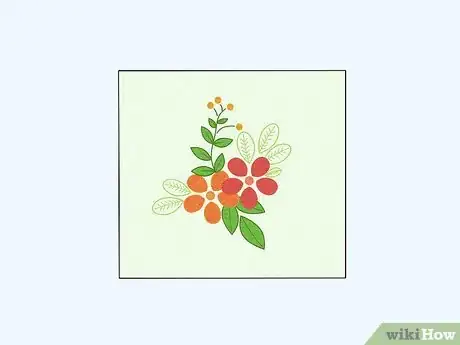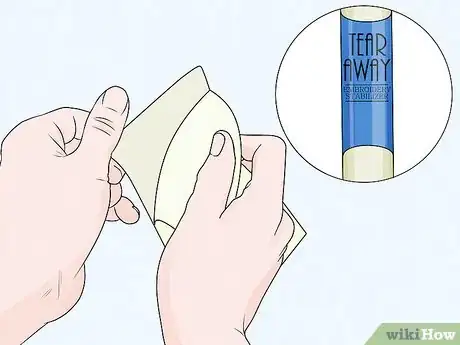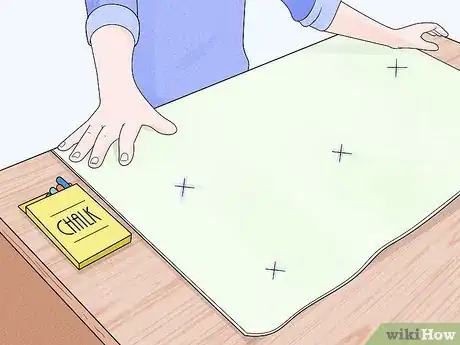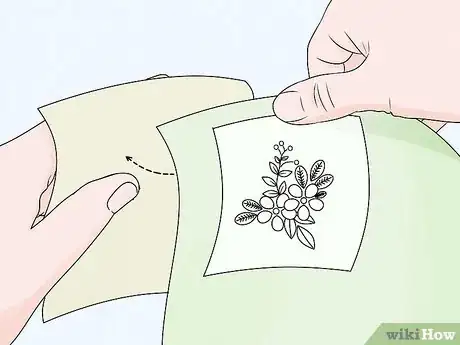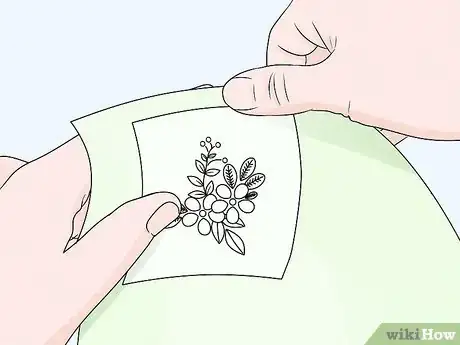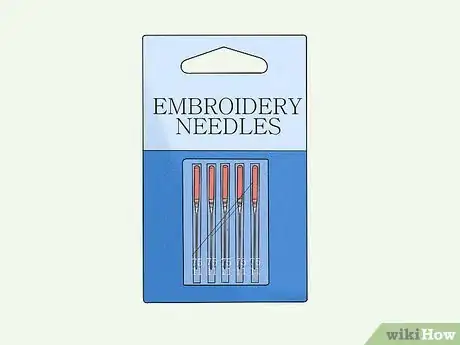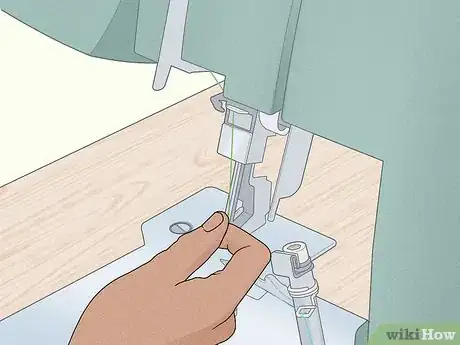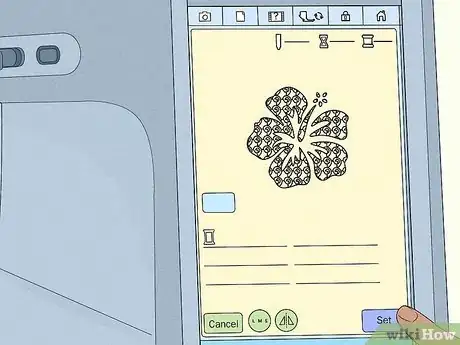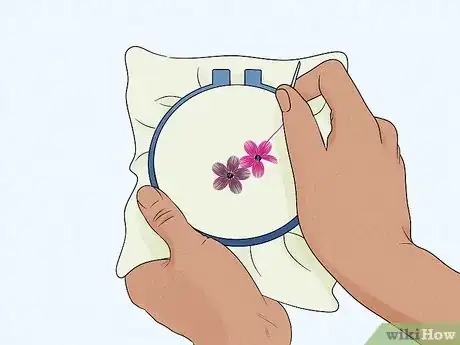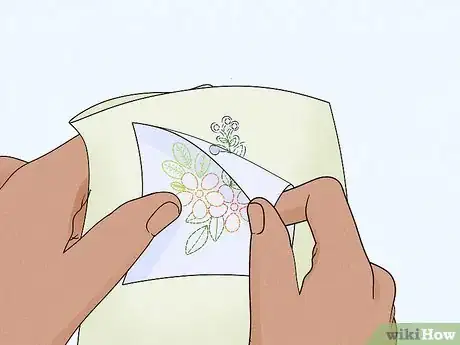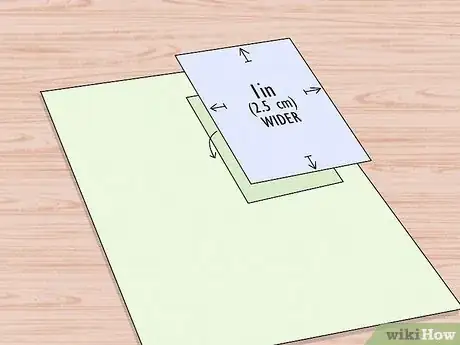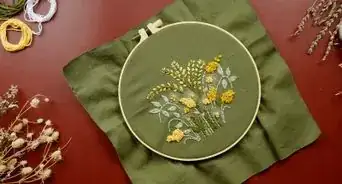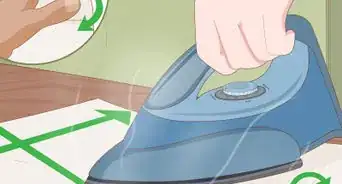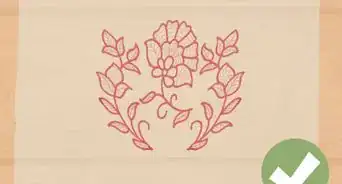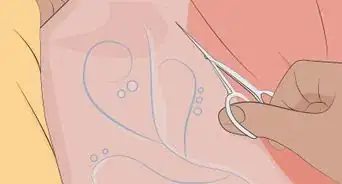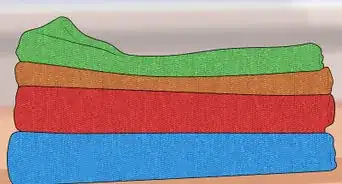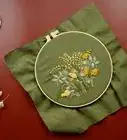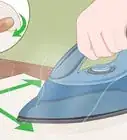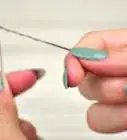This article was co-authored by Kpoene Kofi-Bruce. Kpoene Kofi-Bruce is a tailor, couture wedding gown designer, and the Creative Director of Mignonette Bridal and Ette the Wedding Tailor in Chicago, Illinois. With nearly two decades of experience as a wedding gown designer, small business owner, and vintage sewing enthusiast, Kpoene specializes in wedding gown design and the social history of wedding dresses. She received a BA in Creative Writing from Middlebury College and studied the business of fashion at the Fashion Institute of Technology. She is also a graduate of the Goldman Sachs 10KSB program and the Chicago Fashion Incubator and has written about wedding fashion for Jezebel, Catalyst, the Sun Times, and XO Jane.
There are 9 references cited in this article, which can be found at the bottom of the page.
This article has been viewed 16,409 times.
Silk is a delicate fabric that requires special handling, especially when you sew with it. If you want to embroider silk to make it even more luxurious, the special needs of this fabric can pose some problems. Luckily, there are ways you can get around these challenges and embroider an attractive design onto a silk fabric. Start by getting the right materials for your project, marking the fabric where you want to embroider it, and attaching it to your stabilizer. Then, you can embroider the fabric using a machine or by hand.
Steps
Marking and Stabilizing the Fabric
-
1Opt for a small, simple design for translucent or lightweight silk. It’s best to save complex designs for heavier silk. You can browse the designs that are already programmed into your embroidery machine if it came pre-loaded with designs, or download a design that you want to use. If you’re embroidering by hand, purchase or download a simple design to use from a website.[1]
- Try embroidering the silk with delicate flowers, thin script letters, or small hearts.
-
2Select tearaway stabilizer if you’re embroidering translucent silk. Only use cutaway stabilizer for a heavier silk material. Stick with tearaway stabilizer for light to medium silk fabric.[2] There are also water soluble stabilizers, but these are only suitable for silk that is machine washable. If you’re working with silk that you do not want to wash, then it’s best to avoid a water soluble stabilizer.[3]
- Check the care instructions for the silk you’re using. If the silk you’re using is dry-clean only, soaking the silk in water to remove the stabilizer may affect the appearance of your fabric.
Advertisement -
3Mark on the silk with chalk where you want to embroider it. Measure the design you’re using to determine how large it is. Then, create X marks on the fabric with a piece of chalk where you want to position the designs. Make the X marks the same size as the design you will be embroidering onto the silk.[4]
- Try to space the designs out evenly if you’re doing them all over the fabric. You can estimate the distance between the designs or measure the distance between them for more precision.
-
4Position the design template on the fabric if you’re using one. If you are embroidering by hand, then you’ll likely need to sew through a paper design template to create the design you want. Position the template on front side of the fabric. Pin or use temporary spray adhesive to keep the template in place.[5]
- You can purchase embroidery templates in craft supply stores. There are also many free embroidery patterns available to download and print.
- You can also embroider designs onto the fabric freehand if you feel comfortable doing so.
-
5Lock the stabilizer in the hoop and spray it with temporary adhesive. Temporary adhesive is a spray adhesive that’s meant for fabric. Position the stabilizer sheet so that the edges extend over the sides of the hoop. Then, close the top hoop over the bottom one and secure them using the latch or screws on the hoop. Spray the stabilizer with a temporary adhesive so that the silk fabric will stick to it. This will keep the fabric in place while you embroider it.[6]
- It’s important to lock the stabilizer rather than the silk fabric. Otherwise, the silk may wrinkle or get crease marks from the hoop.
-
6Press the fabric against the stabilizer with the design centered. Choose where you want to start embroidering and press the back side of the fabric against the sticky stabilizer paper. Check to see if the chalk mark or template is centered in the hoop. If not, pull the fabric away from the stabilizer paper and reposition it.[7]
Warning: Be very careful not to crease the edges of the silk as you secure it against the stabilizer paper. These creases may be difficult to remove.
Adding the Design
-
1Purchase a sharp or embroidery needle in size 75/11. Sharp needles have extra pointy ends, which makes it easier to penetrate through delicate materials. Embroidery needles are specially made to do this as well. Make sure that you select a needle in size 75/11 to ensure that it won’t create large holes in the delicate silk fabric.[8]
- You can purchase a sharp or embroidery needle in a craft supply store or online.
Tip: Always start with a new needle whether you are embroidering by hand or by machine. This will help to ensure that the needle can easily penetrate the fibers.
-
2Thread the needle on your machine or for sewing by hand. Cut the end of the thread about 1 in (2.5 cm) from the end and then wet it with a bit of saliva to stiffen it. Insert the end of the thread through the eye of the sewing machine needle or through the eye of the hand sewing needle. Pull through about 6 in (15 cm) of the thread to the other side of the needle.
- If you’re sewing by hand, use embroidery floss. This comes in 6-strand skeins that are about 38 in (97 cm) long. You can separate the strands to get the desired thickness for your stitches.[9]
-
3Select the desired design to embroider by machine. Position the embroidery hoop on your machine if you’re using one. Select the design you want to add from the menu on your embroidery machine, and then start the machine. The machine will embroider your design into the fabric.[10]
- Check the manufacturer’s instructions for specific information on how to use your embroidery machine.
-
4Sew in and out of the fabric if you’re embroidering by hand. If you’re embroidering by hand, hold the embroidery hoop with your non-dominant hand and insert it through the backside of your project. Then, sew in and out of the fabric following the pattern or template you’re using.[11]
Tip: If you’re new to embroidery, you may want to practice on a piece of scrap fabric before embroidering silk since it is often more expensive than other fabrics.
-
5Tear the stabilizer away from the fabric slowly. After you have finished sewing the design onto the silk fabric, leave the stabilizer sheet locked in the hoop. Then, gently pull the fabric away from the stabilizer. The stabilizer paper should tear easily leaving only a few small pieces embedded in the stitches of the embroidered silk. Turn the fabric over to the wrong (back) side and use your fingers to carefully pry out these small pieces of paper.[12]
- You can also use a pair of tweezers to pull out very small pieces of paper stuck in the stitches. Just be careful not to grasp the thread or fabric by accident.
-
6Cover the hole in the stabilizer paper to continue adding designs. If you have more designs that you want to embroider onto the silk fabric, you don’t need to get a whole new sheet of stabilizer. Cut out a piece a stabilizer paper large enough to cover the hole and overlap the edges by 1 in (2.5 cm) on all sides. Then, spray temporary adhesive onto the stabilizer paper that’s in the hoop, and press the smaller piece of stabilizer paper against it. Then, spray the whole thing with temporary adhesive again and press the silk fabric against it as you did before.[13]
- Make sure that the chalk mark or template is centered within the hoop.
Expert Q&A
-
QuestionCan you embroider a design onto silk without a machine?
 Kpoene Kofi-BruceKpoene Kofi-Bruce is a tailor, couture wedding gown designer, and the Creative Director of Mignonette Bridal and Ette the Wedding Tailor in Chicago, Illinois. With nearly two decades of experience as a wedding gown designer, small business owner, and vintage sewing enthusiast, Kpoene specializes in wedding gown design and the social history of wedding dresses. She received a BA in Creative Writing from Middlebury College and studied the business of fashion at the Fashion Institute of Technology. She is also a graduate of the Goldman Sachs 10KSB program and the Chicago Fashion Incubator and has written about wedding fashion for Jezebel, Catalyst, the Sun Times, and XO Jane.
Kpoene Kofi-BruceKpoene Kofi-Bruce is a tailor, couture wedding gown designer, and the Creative Director of Mignonette Bridal and Ette the Wedding Tailor in Chicago, Illinois. With nearly two decades of experience as a wedding gown designer, small business owner, and vintage sewing enthusiast, Kpoene specializes in wedding gown design and the social history of wedding dresses. She received a BA in Creative Writing from Middlebury College and studied the business of fashion at the Fashion Institute of Technology. She is also a graduate of the Goldman Sachs 10KSB program and the Chicago Fashion Incubator and has written about wedding fashion for Jezebel, Catalyst, the Sun Times, and XO Jane.
Couture Bridal Designer Yes, just make sure you trace your design first, then place your needle exactly on the tracing, as silk can "shatter."
Yes, just make sure you trace your design first, then place your needle exactly on the tracing, as silk can "shatter." -
QuestionHow do you transfer letters to silk for embroidery?
 Kpoene Kofi-BruceKpoene Kofi-Bruce is a tailor, couture wedding gown designer, and the Creative Director of Mignonette Bridal and Ette the Wedding Tailor in Chicago, Illinois. With nearly two decades of experience as a wedding gown designer, small business owner, and vintage sewing enthusiast, Kpoene specializes in wedding gown design and the social history of wedding dresses. She received a BA in Creative Writing from Middlebury College and studied the business of fashion at the Fashion Institute of Technology. She is also a graduate of the Goldman Sachs 10KSB program and the Chicago Fashion Incubator and has written about wedding fashion for Jezebel, Catalyst, the Sun Times, and XO Jane.
Kpoene Kofi-BruceKpoene Kofi-Bruce is a tailor, couture wedding gown designer, and the Creative Director of Mignonette Bridal and Ette the Wedding Tailor in Chicago, Illinois. With nearly two decades of experience as a wedding gown designer, small business owner, and vintage sewing enthusiast, Kpoene specializes in wedding gown design and the social history of wedding dresses. She received a BA in Creative Writing from Middlebury College and studied the business of fashion at the Fashion Institute of Technology. She is also a graduate of the Goldman Sachs 10KSB program and the Chicago Fashion Incubator and has written about wedding fashion for Jezebel, Catalyst, the Sun Times, and XO Jane.
Couture Bridal Designer If you're adding a wedding date or something sentimental to a gown in a place where only the wearer will see it, I recommend embroidering onto a patch and then attaching that, rather than embroidering directly onto the garment.
If you're adding a wedding date or something sentimental to a gown in a place where only the wearer will see it, I recommend embroidering onto a patch and then attaching that, rather than embroidering directly onto the garment.
Things You’ll Need
- Tearaway stabilizer
- Temporary adhesive
- 1 sharp or embroidery needle in size 75/11
- Embroidery thread or floss
- Embroidery hoop
- Embroidery machine (optional for sewing by machine)
- Tweezers (optional)
- Scissors
References
- ↑ https://www.emblibrary.com/EL/elprojects/pdf/pr1459.pdf
- ↑ https://www.emblibrary.com/EL/elprojects/pdf/pr1459.pdf
- ↑ https://www.youtube.com/watch?v=AmhoI6yGG3Q&feature=youtu.be&t=87
- ↑ https://www.youtube.com/watch?v=AmhoI6yGG3Q&feature=youtu.be&t=150
- ↑ https://www.dmc.com/us/free-patterns-5041/free-patterns-5042/free-embroidery-patterns-5043.html
- ↑ https://www.youtube.com/watch?v=AmhoI6yGG3Q&feature=youtu.be&t=87
- ↑ https://www.youtube.com/watch?v=AmhoI6yGG3Q&feature=youtu.be&t=190
- ↑ https://www.emblibrary.com/EL/elprojects/pdf/pr1459.pdf
- ↑ https://embroiderersguild.com/index.php?page_no=233&page_menu=starting-to-stitch
